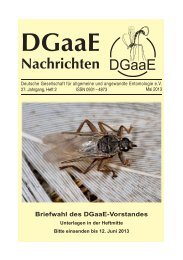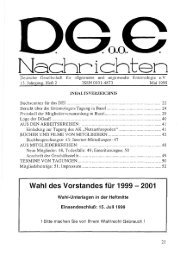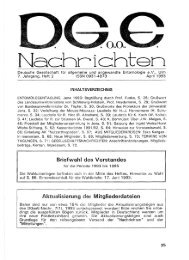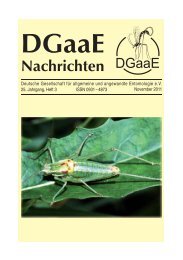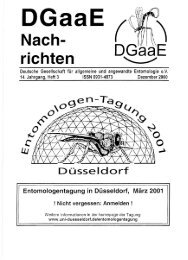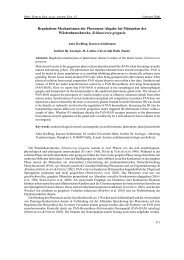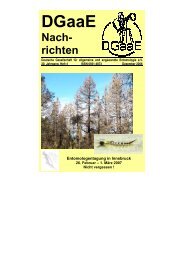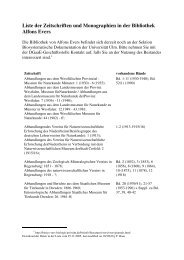Beiträge der Hymenopterologen-Tagung in Stuttgart (1 ... - DGaaE
Beiträge der Hymenopterologen-Tagung in Stuttgart (1 ... - DGaaE
Beiträge der Hymenopterologen-Tagung in Stuttgart (1 ... - DGaaE
Sie wollen auch ein ePaper? Erhöhen Sie die Reichweite Ihrer Titel.
YUMPU macht aus Druck-PDFs automatisch weboptimierte ePaper, die Google liebt.
Beitr. Hymenopt.-<strong>Tagung</strong> <strong>Stuttgart</strong> (2004) 25<br />
weiter nahe, dass Arterkennung e<strong>in</strong>e Rolle bei <strong>der</strong> Evolution des Duftstoffsammels spielt o<strong>der</strong><br />
gespielt hat.<br />
Literatur<br />
BEMBÉ, B. 2004: Functional morphology <strong>in</strong> male eugloss<strong>in</strong>e bees and their ability to spray fragrances (Hymenoptera,<br />
Apidae, Eugloss<strong>in</strong>i). — Apidologie 35: 283-291<br />
ELTZ, T., WHITTEN, W.M., ROUBIK, D.W. & LINSENMAIR, K.E. 1999: Fragrance collection, storage, and accumulation<br />
by <strong>in</strong>dividual male orchid bees. — Journal of Chemical Ecology 25: 157-176<br />
ELTZ, T., ROUBIK, D.W. & WHITTEN, W.M. 2003: Fragrances, male display and mat<strong>in</strong>g behaviour of Euglossa<br />
hemichlora - a flight cage experiment. — Physiological Entomology 28: 251-260<br />
Is there a particular ant fauna<br />
<strong>in</strong> Araucarian ra<strong>in</strong> forests <strong>in</strong> South-eastern Brazil?<br />
Manfred VERHAAGH<br />
Staatliches Museum für Naturkunde Karlsruhe<br />
Erbpr<strong>in</strong>zenstr. 13, D-76133 Karlsruhe, manfred.verhaagh@smnk.de<br />
Investigations of the myrmecofauna of the litter stratum <strong>in</strong> a mounta<strong>in</strong>ous Araucaria forest (960<br />
m) and a nearby coastal escarpment forest without this neotropical conifer (670 m) on the Serra<br />
Geral <strong>in</strong> Rio Grande do Sul, Bazil, showed that the spectrum of the ant communities was very<br />
similar <strong>in</strong> both forest types. By standardised litter extraction <strong>in</strong> W<strong>in</strong>kler bags a few more species<br />
could be recorded <strong>in</strong> the escarpment than <strong>in</strong> the Araucaria forest comb<strong>in</strong>ed with a higher density<br />
of species and <strong>in</strong>dividuals and higher values of diversity and evenness <strong>in</strong>dices. The difference<br />
<strong>in</strong> the <strong>in</strong>dices decreased when they were recalculated with presence-absence <strong>in</strong>stead of absolute<br />
abundance data. The dom<strong>in</strong>ance structure <strong>in</strong> the Araucaria forest was strongly biased towards<br />
one species of Hypoponera which was present <strong>in</strong> all samples and numbered half of the specimens.<br />
Among the 20 species with significant differences <strong>in</strong> site frequency only 3 could be found<br />
exclusively <strong>in</strong> the Araucaria forest and 4 <strong>in</strong> the escarpment forest. Generally, the litter stratum<br />
of both forest types was dom<strong>in</strong>ated by species of Hypoponera, Pheidole and Solenopsis<br />
(Diplorhoptrum). Species richness estimated by different extrapolations resulted <strong>in</strong> about 100<br />
litter ant species for either forest plot, show<strong>in</strong>g that our samples covered certa<strong>in</strong>ly more than<br />
50% of them.<br />
The differences <strong>in</strong> the structure of the litter ant communities at the two neighbour<strong>in</strong>g forests<br />
presumably reflect the local microclimate conditions. The escarpment forest at a lower altitude<br />
on the steep slopes towards the Atlantic ocean is much more sun-exposed, result<strong>in</strong>g <strong>in</strong> higher<br />
ambient temperatures.<br />
In a second study on arboricolous ants a so far unknown high number of ant species associated<br />
with Araucaria trees could be recorded. However, no specialised „araucariocolous“ ants seem<br />
to be among the species found because most of them could also be detected on nearby broadleafed<br />
trees or on the ground. In most taxa of the Araucarian ant fauna the workers are small and<br />
the colonies are not very populous. Only a Crematogaster and a Myrmelachista species were<br />
common and conspicuous on Araucaria trees and may dom<strong>in</strong>ate the complete crown of a<br />
particular tree with there often polydomous colonies.




